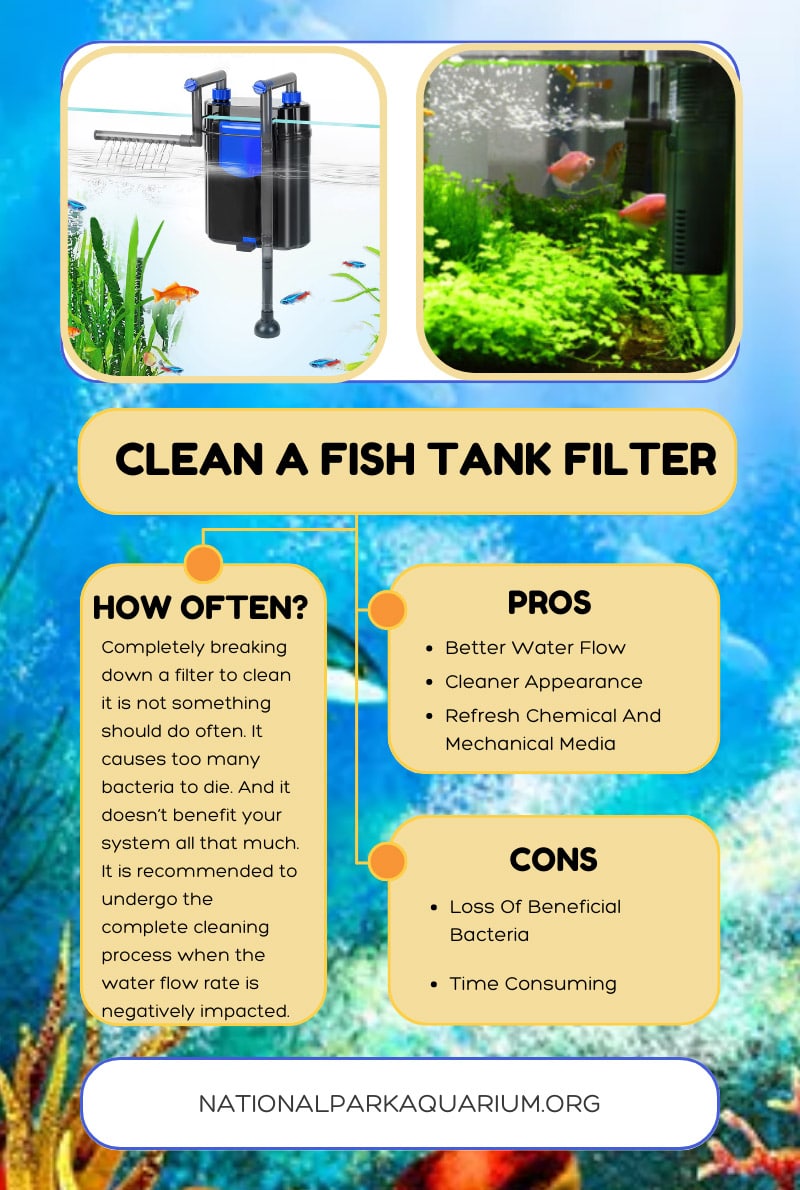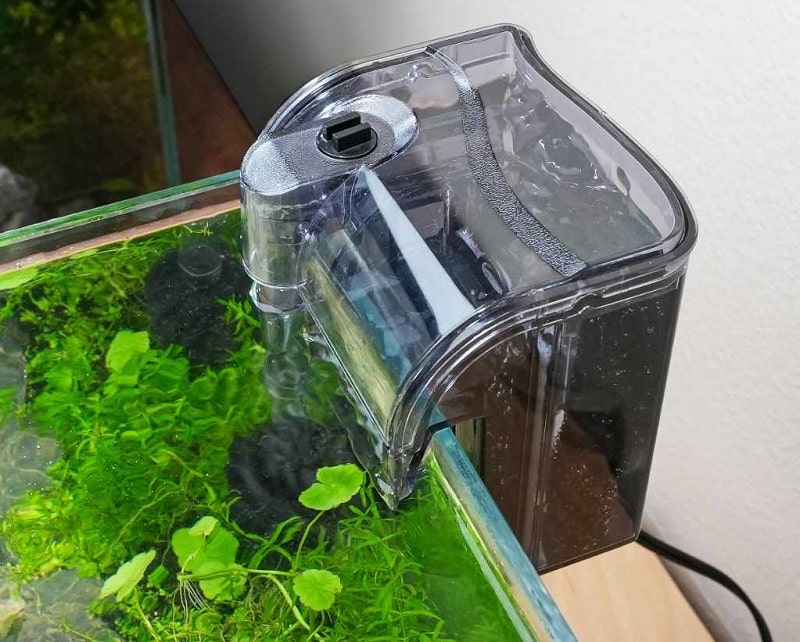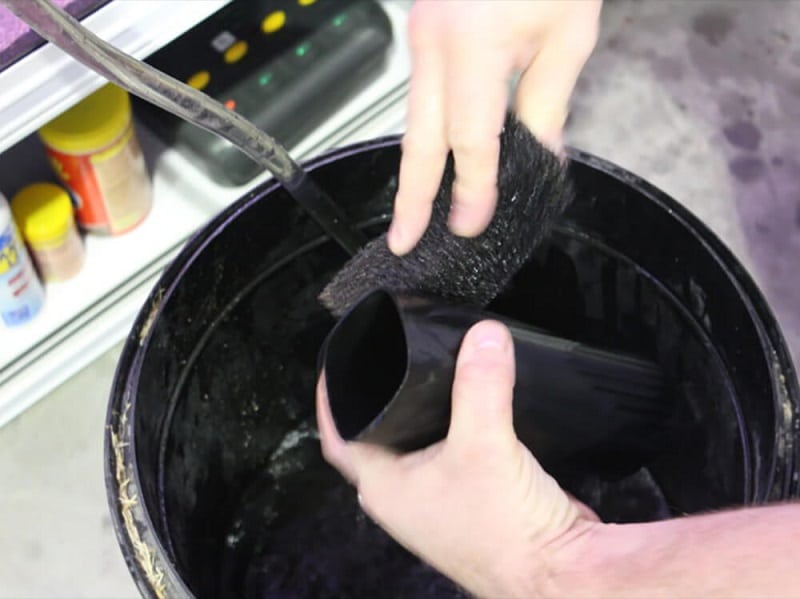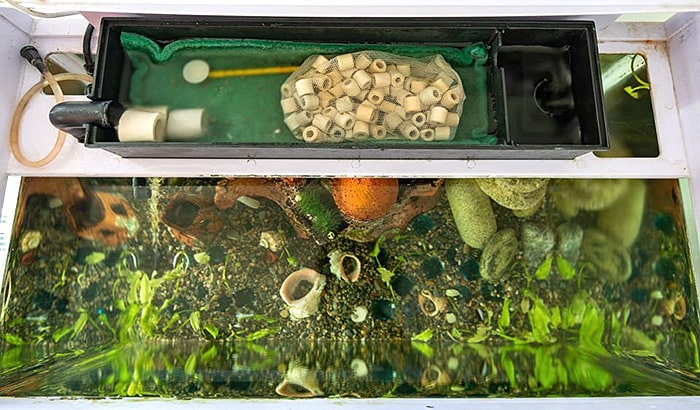We shouldn’t allow the tank filter to remain unattended for an extended period, letting it become excessively dirty before opting to clean it. In fact, regularly cleaning your aquarium filter is an essential part of maintaining a healthy and thriving aquatic ecosystem. And it should be done every month.
This blog post will go over the steps necessary to clean fish tank filter without killing bacteria. National Park Aquarium will also provide some helpful tips on keeping your aquarium filter in good condition for years to come.
Why to Clean Fish Tank Filter?
The filter, being the lifeblood of the aquarium, requires consistent cleaning to ensure the fish remain joyful and in prime health. Make it a routine to clean it concurrently with your water changes, which should occur every 2 to 3 weeks. For this, have on hand the bucket of water you’ve set aside from the tank refresh.

How to Clean Hang On Back (HOB) Power Aquarium Filter
Power filters are another popular aquarium filter and are often used in freshwater and saltwater tanks. Power filters are easy to maintain and are very effective at filtering out waste and debris from your aquarium water.
Cleaning your aquarium filter is an important part of maintaining a healthy environment for your fish. Aquarium filters remove debris and waste from the water, keeping it clean and clear. Power filters are a type of aquarium filter that uses an impeller to create water movement, which helps to remove waste and debris from the water.

What you Need to Clean Hang On Back fish-tank Filter
- Filter media (such as activated carbon or filter pads)
- Bucket
- Distilled water or dechlorinated water
- Latex gloves (optional)
- A pitcher of tank water
Step-by-Step to Clean Hang On Back (Power) Aquarium Filter
- Put on the gloves as you wash the filters and handle tank water.
- Unplug the aquarium filter from the power outlet and remove it from the aquarium.
- Open the aquarium filter and remove the filter media. Most power filters have a canister that can be unscrewed to access the filter media.
- Rinse the filter media in distilled water. Be sure to use gloves if you are using activated carbon, as it can be harmful if it comes into contact with your skin.
- Clean the sponge in the pitcher of tank water, as instructed in the guide above.
- Replace the filter media in the aquarium filter and screw the canister back on.
- Rinse the exterior of the aquarium filter in a bucket of distilled water.
- Wipe down the aquarium filter with a clean cloth to remove dirt or debris.
- Install the sponge back to the filter, then pour some tank water inside the filter. Place the aquarium filter back in the aquarium and plug it into the power outlet.
- Turn on the aquarium filter and allow it to run for 24 hours before adding fish to the aquarium.
How to Clean Sponge Filter Without Killing Bacteria?
Sponge filters are one of the most popular aquarium filters on the market. Sponge filters are easy to maintain and efficiently filter out debris and waste from your aquarium water.
They are often used in freshwater tanks and can be an excellent choice for beginner aquarists.

What you will need to Clean Sponge Filters
- Tank water
- Bucket or container
- A pair of gloves
Step 1: Wear gloves and prepare the tank water
Put on your rubber gloves to avoid touching the dirty sponge and tank water with your bare hands.
Also, pour some tank water into a small bucket.
Step 2: Remove the sponge
Remove the aquarium sponge filter from your tank and place it in the bucket or container of old tank water.
Please know that you should not wash the sponge with clean water to avoid killing all the beneficial bacteria in the sponge.
Step 3: Wash the sponge
Gently squeeze the sponge filter and wash it until the water can run through it.
Please know that you should replace the sponge if it shrinks too much after being squeezed or shows signs of disintegration.
However, you should replace one or half a sponge since the new one will take more than a month to absorb substances and become mature enough for it to work.
Source: Girl Talks Fish
How to Clean Canister Filter Without Killing Bacteria?

To clean a canister filter without killing bacteria, it is essential to use a gentle cleaning solution and avoid harsh chemicals.
You should use a mild vinegar solution or fresh water to rinse away any dirt and debris. Vinegar is a natural disinfectant and will not harm your beneficial bacteria.
Canister filters are usually made up of three main parts: the canister itself, the media basket, and the hosing.
- The canister is the part that holds the filter media and water.
- The media basket is where the filter media is stored.
- And the hose connects the canister to the aquarium.
To clean a canister filter, you will need to remove all of these parts from the tank. Let’s dive into the detailed steps for cleaning.
What you need to clean canister filter
- Lukewarm water
- White vinegar
- A soft brush
- A clean towel
Step 1: Disassemble the filter
To clean a canister filter, turn the shut-off valves connected to the tubes off. And then, you will need to disassemble the canister filter. This means taking apart the various parts of the filter, including the motor housing, the intake tube, and the media baskets.
To prevent making a mess out of this disassembling process, you should take a clean towel to catch the housing and the tube when disconnecting them.
Step 2: Rinse all of the parts in water
Once you have taken the filter apart, rinse all of its parts in lukewarm water. This will help to remove any debris or particles that may be clinging to them.
Next, you will need to soak the parts in a vinegar solution, which is mixed with water in a ratio of 1:1. This will help to break down any buildup that may be on the parts. And you should not worry since this ingredient is rather safe.
Step 3: Clean the media baskets
The next step is to clean the media baskets. These are the parts of the filter where the actual filtering takes place. To clean them, simply soak them in lukewarm water in a bucket for some minutes, and then scrub them with a soft brush.
Step 4: Clean the hose and intake tube
After you have cleaned the media baskets, take a look at the hosing and intake tube. These parts can also get clogged with debris over time.
You should not be too rough with these parts, you can remove the guts from them by submerging them into the lukewarm water. Then, use the soft brush to scrub the dirty parts.
Step 5: Reassemble the filter
Once you have cleaned all of the parts of the filter, it is time to reassemble it. Simply put all of the parts back together in their proper order and then turn on the filter. Your canister filter should now be clean and ready to use.
Be sure to reconnect the hosing and make sure that all of the parts are secure before turning on the filter.
Step 6: Test the filter
After you have reassembled the filter, it is important to test it to make sure that it is working properly. To do this, simply turn on the filter and let it run for a few minutes. If everything appears to be working properly, then you are all done!
How Often Should You Clean Aquarium Filter?
In-tank filters, much like their hang-on counterparts, necessitate cleaning at least once a month for optimal performance. For the well-being of your aquatic residents, it’s best to aim for a cleaning every two weeks.
Conclusion
As you can see, cleaning your aquarium filter is not a complicated process. By following the simple steps “how to clean aquarium filter” in this article, you should be able to keep your aquarium looking and running great for years to come.
Have any questions about filter cleaning or other aspects of aquarium maintenance? Let us know in the comments below, and we’ll do our best to help you out.




